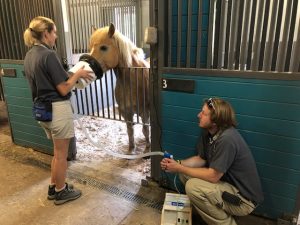
© Alex Walker
Horses, as a species, are prey animals. They are often space conscious and uniquely aware of their surroundings and sensitive to the elements within them. Physically large and robust animals, horses easily dwarf their trainers or handlers and are incredibly strong. Although these are important traits for livestock animals, their size and strength can result in a “heavy-handed” approach being taken to physically manipulate and coerce them into a specific behavior or position. This approach still pervades all aspects of traditional horsemanship and even extends to routine medical care or lifesaving husbandry behaviors. In this article, we are going to discuss how positive reinforcement can be used to not only teach an important medically relevant behavior (administering medication through a nebulizer) but that this style of training can also build strong, steady and complex behaviors. Read article.
